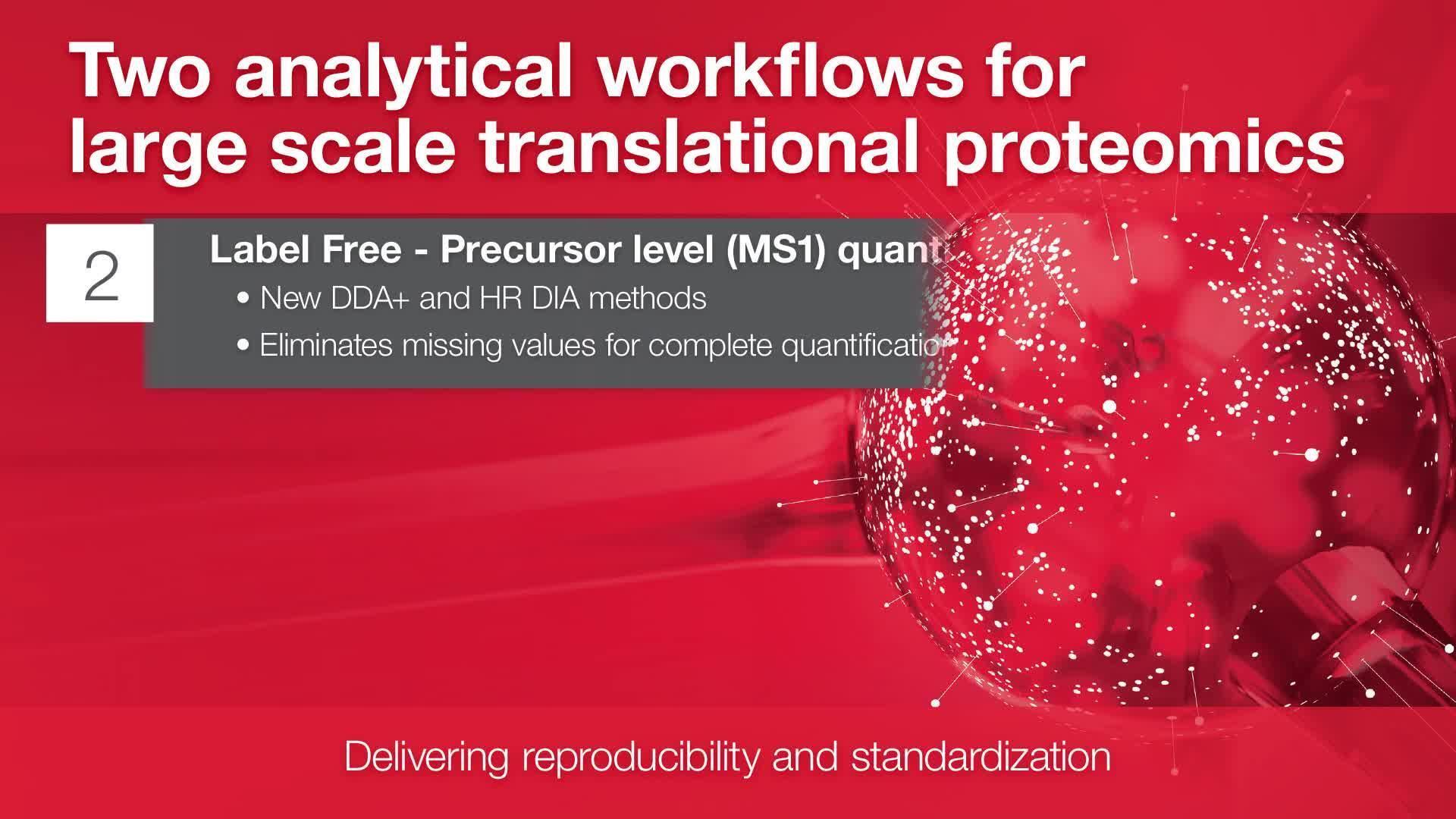
Large scale proteomics
Recent advances in mass spectrometry have skyrocketed the capabilities in translational proteomics, impacting our understanding of health and disease. Translational proteomics complements other omics disciplines (genomics, transcriptomics, and metabolomics/lipidomics), delivering new workflows that produce clinically relevant results that are quantitative, reproducible, standardized, and scalable.
Thermo Scientific Orbitrap LC-MS workflows lead the way to accelerate your journey from discovery research to clinical applications, and support your success every step of the way.
Translational research is accelerating the conversion of basic scientific knowledge into tests, treatments and practices that improve human health. Translational proteomics most frequently involves the discovery of potential clinically relevant protein biomarkers and moves as quickly as possible from positive identification to verification and validation.

The complexities of disease research require a new level of collaboration among researchers, labs, and integration of various omics fields. We partner with key thought leaders to bring you the most current approaches and best practices in this field.
Standardized and reproducible workflows for large scale proteomics
Thermo Fisher is uniquely positioned to deliver differentiated solutions for translational proteomics researchers. Two analytical proteomics workflows have been developed that deliver reproducibility and standardization across the clinical research field.
The tandem mass tag (TMT) workflow is a large scale, multiplexed quantitative proteomics approach that uses isobaric tags or labels to enable high-throughput quantitative screening. It is the most precise and reproducible quantitative workflow in proteomics.
Proteomics insights complements genomics results. In cancer research, for example, Proteomics connects somatic mutations to cancer signaling and elucidates functional consequences. Proteogenomics signatures have also been shown to have potential utility as therapeutic targets in breast cancer xenografts.
The TMT multiplexing quantitative proteomics workflow has found a very enthusiastic adoption in many cancer research labs, delivering high throughput and depth of analysis.
This multiplexing workflow leverages the Orbitrap Tribrid MS system with its unique SPS-MS3 capability to deliver accurate and precise quantitation.
Products for TMT multiplexing workflow
Publications
Resources
Precursor level quantitation is the new standard for label-free quantitation. Using this approach, missing quantitative values are reduced in order to provide complete quantitation. The label-free quantitation workflow delivers reproducibility and accuracy for large sample cohorts and is designed for flexibility serving the proteomics and clinical research community.
There are two approaches commonly used for precursor level quantitation: DDA+ (data dependent acquisition) and HR-DIA (high-resolution data-independent acquisition).
The DDA+ workflow takes the proven data-dependent acquisition method into an optimized complete workflow for the rigors of standardized label free quantitation (LFQ). This workflow virtually eliminates the "missing value" problem of traditional DDA.
The HR-DIA is a complementary LFQ workflow suited for large-scale studies, due to its ability to rapidly identify and reproducibly quantify all detectable peptides within an LC-MS analysis. Biognosys’ Spectronaut software provides an efficient pipeline for spectral library creation and processing of large DIA datasets.
Both of these label-free precursor level quantitation solutions leverage the capillary-flow Thermo Scientific UltiMate 3000 RSLCnano system, with new Thermo Scientific 150um ID EASY-Spray column and the new Q Exactive HF-X MS to balance sensitivity, robustness and throughput.
Products for Precursor Level Quantitation workflow
Publications
Resources
The tandem mass tag (TMT) workflow is a large scale, multiplexed quantitative proteomics approach that uses isobaric tags or labels to enable high-throughput quantitative screening. It is the most precise and reproducible quantitative workflow in proteomics.
Proteomics insights complements genomics results. In cancer research, for example, Proteomics connects somatic mutations to cancer signaling and elucidates functional consequences. Proteogenomics signatures have also been shown to have potential utility as therapeutic targets in breast cancer xenografts.
The TMT multiplexing quantitative proteomics workflow has found a very enthusiastic adoption in many cancer research labs, delivering high throughput and depth of analysis.
This multiplexing workflow leverages the Orbitrap Tribrid MS system with its unique SPS-MS3 capability to deliver accurate and precise quantitation.
Products for TMT multiplexing workflow
Publications
Resources
Precursor level quantitation is the new standard for label-free quantitation. Using this approach, missing quantitative values are reduced in order to provide complete quantitation. The label-free quantitation workflow delivers reproducibility and accuracy for large sample cohorts and is designed for flexibility serving the proteomics and clinical research community.
There are two approaches commonly used for precursor level quantitation: DDA+ (data dependent acquisition) and HR-DIA (high-resolution data-independent acquisition).
The DDA+ workflow takes the proven data-dependent acquisition method into an optimized complete workflow for the rigors of standardized label free quantitation (LFQ). This workflow virtually eliminates the "missing value" problem of traditional DDA.
The HR-DIA is a complementary LFQ workflow suited for large-scale studies, due to its ability to rapidly identify and reproducibly quantify all detectable peptides within an LC-MS analysis. Biognosys’ Spectronaut software provides an efficient pipeline for spectral library creation and processing of large DIA datasets.
Both of these label-free precursor level quantitation solutions leverage the capillary-flow Thermo Scientific UltiMate 3000 RSLCnano system, with new Thermo Scientific 150um ID EASY-Spray column and the new Q Exactive HF-X MS to balance sensitivity, robustness and throughput.
Products for Precursor Level Quantitation workflow
Publications
Resources
Translation proteomics videos
Dr. Andreas Huhmer, Director of Marketing for Proteomics and Metabolomics at Thermo Fisher Scientific, discusses the need for robust, standardized and scalable methods for large sample cohorts.









